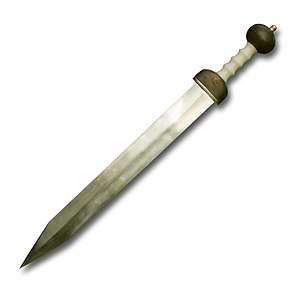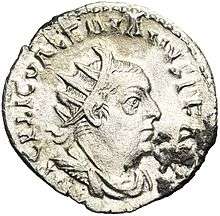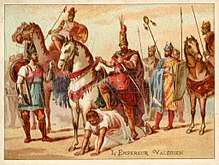Battle of Barbalissos
The Battle of Barbalissos was fought between the Sasanian Persians and Romans at Barbalissos. Shapur I used Roman incursions into Armenia as pretext and resumed hostilities with the Romans. The Sassanids attacked a Roman force of 60,000 strong at Barbalissos and the Roman army was destroyed. The defeat of this large Roman force left the Roman east open to attack and led to the eventual capture of Antioch and Dura Europos three years later. This battle is only known through Shapur I's inscription at Naqsh-e Rostam.
| Battle of Barbalissos | |||||||
|---|---|---|---|---|---|---|---|
| Part of the Roman–Persian Wars | |||||||
| |||||||
| Belligerents | |||||||
| Sassanid Empire | Roman Empire | ||||||
| Commanders and leaders | |||||||
| Shapur I | |||||||
| Strength | |||||||
| Unknown | 60,000[4] | ||||||
| Casualties and losses | |||||||
| Unknown | Roman forces annihilated[5][6] | ||||||
Overview
The Battle of Barbalissos was fought between the Sassanid Persians and Romans at Barbalissos, an old Roman town near Aleppo in modern-day Syria and close to the Euphrates River. The battle was fought in 252 when Shapur I (239-270 CE), King of the Sassanian Empire and son of Ardashir I, led his army from the Euphrates River and met with a Roman army 60,000 strong of legionaries, archers, and Roman cavalry. Although the number of forces of Sassanid Persians are unclear, through tactics and use of strategy Shapur I managed to win the battle and open a way through the Syrian cities and castles.[7][8] The major defeat of the Battle of Barbalissos was very costly for the Roman emperor Valerian who appointed many more armies to stop Shapur I from quick advance into Roman soil and later on he decided to lead a major army of 70,000 legionaries himself.[9]
History

Romans
For 1,000 years, the Roman Empire was a major power in Europe. Roman emperors controlled most of Southern Europe, North Africa, and some parts of Asia giving them the numbers to encounter any intruding forces. There would be celebrations in honor of military victories to remind people of the power of the Roman army. The republic of Ancient Rome changed into a complete monarchy in 27 BCE with Augustus as the first emperor until the Battle of Barbalissos during the monarchy of Valerian the Elder (253-260 CE).[10] During the life of the Roman Empire, many great architectural and historical entertainment places such as the coliseum were made for people and nobles of Rome. The people financially were separated into three branches of poor, medium, and noble. Most people were fed enough to avoid starvation and would join the army to generate a good income for their family. Even with police presence, the slums, where the poor lived, were a common place for criminal activities and many would avoid such places if possible. The Roman army was the main pride and happiness for any person who was born a Roman. The weapons of choice for the Roman soldiers were pilum, gladius, and pugio. The pilum was similar to a javelin used to throw at the enemy but not for hand-to-hand combat. The gladius was the razor sharp blade used for frontier battles. The pugio was a small dagger which was used as the last resort if all other equipment was gone. The Roman legionaries were said to be very disciplined, armored, and ready for any incoming surprises. Captured enemy soldiers from numerous battles automatically became slaves to their noble masters and it was impossible to receive their freedom.[11]
Sassanian Persians:
The Sassanian Empire had the vast majority of Asia which expanded to Europe and Africa during the monarchy of the kings for 410 years of its stand. The Sassanian were feared by many from their massive conquests and advances. Their great libraries and architectures were a way for them to show the history of the empire. Sassanian empire was the only empire of Persia which gave massive amounts of territory and power to its people throughout history. On the level of power, society was divided into priests, warriors, secretaries, and commoners. Petty rulers, royal family, priests, and great landlords had the highest level of power in society and therefore had more available options towards their way of choosing their lifestyle. The monarchy of Sassanids began from Ardashir I (224-244 CE) until the second king of kings Shapur I who fought the battle of Barbalissos and became known as "the Great". There were many historians and artists during the Sassanian empire who made books and drawings of king's achievements and conquest. They were known mostly for the fascinating art and the strength of their military. The military of Sassanian empire was nobles and medium class people who would undergo "hard service" which taught them of different military tactics, maneuvers, and strategy. They would come out as professional soldiers with full body armor taking part as an archer, infantry, or heavy cavalry. The commanders wrote manuals on art of archery which proved the skill of the Persian archers. The Sassanian heavy cavalry were full of body armor to the point that "they could only see through the small holes in their helmets..".[12] Although they were slow, they were proved to be a big advantage on legionaries of Roman army. The infantry was not as powerful as the cavalry of Sassanid Persians since they were equipped with much less armor and weapons compared to a cavalry unit. Slavery was not used as much in Sassanid empire since the Persian culture did not believe in such beliefs. The Persian army would take captured soldiers as "prisoners of war" rather than slaves and exchange them for money.[13]
Leadership

Valerian the Elder (253-260 CE)

. The story of Valerian being used as a mounting block by Shapur, though oft-repeated, is almost certainly apocryphal. As the Bishapur and Naqs-i-Rustam monuments show clearly, Valerian was not humiliated after his capture.
During Valerian's rule, the Roman empire suffered repeated, heavy attacks on its territory. In the West, the Empire proved vulnerable to raids by Franks and others. In the East, Sassanian Persians were a major threat. Valerian let his son Gallienus (253-268 CE) look after the West, while focusing his own efforts in the East. Valerian was not successful since he was defeated and captured near Edessa (260 CE) by Shapur I and eventually died among other prisoners.[14]
Shapur I the Great (239-270 CE)
Shapur I had been given the title of "the Great" since he conquered and maintained multiple Roman territories during his time of power. However, his shining moment began with the battle of barbalissos. It was his second battle with the Romans and since he learned a lot from his father, Ardashir I (224-242 CE), about tactics, strategic traps, and troop formations he took over Syria by "destroying the entirety of 60,000 legionaries" along with many more in the cities after the battle of Barbalissos. He was born and taught to be a leader by his father which later helped on the expansion of Sassanian empire and its power to be grown vastly.[15]
Sources
- Kaveh Farroukh, Sassanian Elite Cavalry AD 224-642
- David S. Potter, The Roman Empire at Bay
- Res Gestae Divi Saporis
References
- "ŠĀPUR I: History – Encyclopaedia Iranica". www.iranicaonline.org. Retrieved 24 February 2020.
- The Cambridge Ancient History: Volume 12, The Crisis of Empire, AD 193-337, "He captured several tomns and then destroyed a Roman army of 60000 men at Barbalissus (Balis) on the large bend of the Euphrates to the north."
- Maria Brosius, The Persians, (Routledge, 2006), 145.
- Maria Brosius, The Persians, 145.
- Encyclopaedia Iranica "And we annihilated a Roman force of 60,000 at Barbalissus [modern Qalʿat al-Bālis, on the left bank of the Euphrates in Syria] and we burned and ravaged the province of Syria and all its dependencies; and in that one campaign we conquered from the Roman empire the following forts and cities (some thirty-six of them are named)"
- The Cambridge Ancient History: Volume 12, The Crisis of Empire, AD 193-337, "He captured several tomns and then destroyed a Roman army of 60000 men at Barbalissus (Balis) on the large bend of the Euphrates to the north."
- Brosius, Lecturer in Ancient History Maria; Brosius, Maria (2006-04-18). The Persians. Routledge. ISBN 9781134359844.
- Millar, Fergus (1993). The Roman Near East, 31 B.C.-A.D. 337. Harvard University Press. ISBN 9780674778863.
- Kia, Mehrdad (2016-06-27). The Persian Empire: A Historical Encyclopedia [2 volumes]: A Historical Encyclopedia. ABC-CLIO. ISBN 9781610693912.
- Kia, Mehrdad (2016-06-27). The Persian Empire: A Historical Encyclopedia [2 volumes]: A Historical Encyclopedia. ABC-CLIO. ISBN 9781610693912.
- "Ancient Rome - History Learning Site". History Learning Site. Retrieved 2017-10-19.
- "History of Iran: Sassanian Army". www.iranchamber.com. Retrieved 2017-10-19.
- "History of Iran: Sassanid Empire". www.iranchamber.com. Retrieved 2017-10-19.
- Millar, Fergus (1993). The Roman Near East, 31 B.C.-A.D. 337. Harvard University Press. ISBN 9780674778863.
- Brosius, Lecturer in Ancient History Maria; Brosius, Maria (2006-04-18). The Persians. Routledge. ISBN 9781134359844.